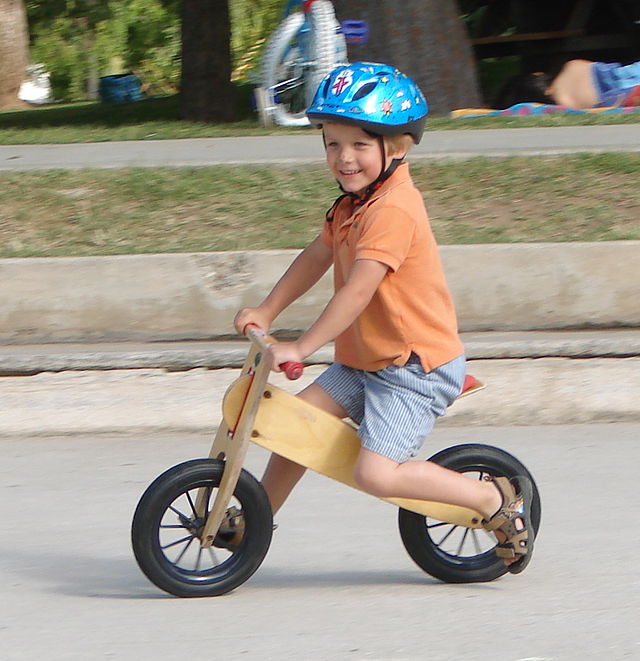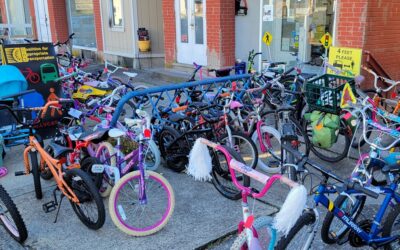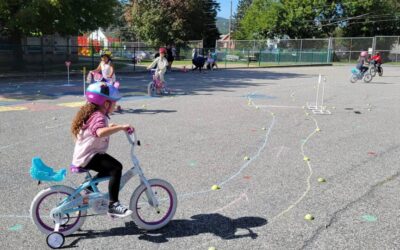
A young cyclist at the Easton Area Community Center (Photo: Express Times)
This post will examine the pros and cons of the two popular methods for teaching a child (or adult) to learn how to ride a bike. What are the ups and downs of training wheels and balance bikes? What are the nuances to make each method work optimally?
The classic image of a child learning to ride a bicycle is a moment in time. This snapshot often captures the breakthrough moment when the child connects their motor skills to pedal, steer and keep their weight over the wheels.
The beauty of two wheels in-line is that the bike can pivot on the axis where the rubber meets the road. You can see this on a micro-level when anyone rides a bicycle. In a straight line, the rider’s weight is always slightly shifting side-to
-side. As a rider’s speed increases above 5 miles per hour, less steering is done by turning the handlebars, and more steering is done by leaning/angling the bicycle into the turn.

A young cyclist at Cheston Elementary School’s bike derby (2007)
In the old school mentality, training wheels provide security for a child to explore pedaling, steering and braking, though limiting development of balance and core engagement. Training wheels can help children to build confidence at low speed (below ~5 mph) on flat ground. Training wheels can simplify bicycle riding to give the child an opportunity to learn how to use coaster (foot) brakes or handbrakes.
Turning with training wheels can be difficult due to the inability to lean the bike into the turn to counterbalance the rider’s weight pushed outward by centrifugal force. In practical terms, children often fall down in turns unless they realize the speed limitation of training wheels. Often when a child enters a turn with training wheels, the inside wheel will lift up off the ground first, followed by lifting up of the rear wheel and loss of control.
Training wheels should be adjusted so that they are 1/4 to 1″off the ground when the bike is upright. If the training wheels are too low, the rear wheel of the bike will not contact the ground and the child will be unable to propel the bike.
These days, balance bikes (or known popularly by the brand name “Strider”) are popular ways to teach children bike balance more intuitively without the limitations of training wheels. Balance bikes are two-wheeled bikes without pedals, cranks, chain or gears. Balance bikes specifically made for striding can be purchased at local bike shops – or any small bicycle can be made into a balance bike by removing the pedals (removal of crankset, chain, etc, is not necessary). What is important for the child is to be able to sit on the seat and have both feet flat on the ground. (Note that this seat height will likely be too low once the child is on a pedal bike). With both feet able to confidently touch the ground, the child can first “walk” while astride, then push off little by little.
Two tips to help with balance are (1) for the child to focus their eyes in the direction they want to go, at least 5-10 feet in front of the bike. (2) When the child realizes that their feet will catch them if they start to fall, they can gain confidence.

A happy guy in action on a balance bike (Photo: Jeremy Miles, Wikimedia Commons 2007)
When the child can glide 10-15 feet with their feet off the ground (knees bent for clearance), they are likely ready to move to a pedal bike. The process may take a day, a week or longer, but it is the writer’s experience that the learning process for a balance bike is much quicker than with training wheels.
Children often learn to balance between ages 3-10, but some older children and adults who have not learned, CAN LEARN TO BALANCE using the balance bike method described above.
Some safety tips for balance bikes: The child should be wearing sturdy pants and sneakers or solid shoes (not flip-flops). Shoe laces should be tucked in. Find an open area (paved or grass) that is just about flat or a very slight downgrade with no traffic. A balance bike with hand brakes is doubly useful for obvious reasons. Note that balance bikes do not inform the child how to use coaster brakes. If transitioning from a balance bike to a bike with only coaster brakes, there will be a learning curve in which the child should be monitored so that they learn to stop the bike.
You are encouraged to relay your experiences learning or teaching a child how to ride a bike and sharing which method worked (or didn’t) work for you! Please leave your comments below! Thank You.
This article contributed by Scott Slingerland, cycling instructor. In the Lehigh Valley, over 20 League of American Bicyclists certified instructors are trained to educate children and parents how to bike smart. CAT-Coalition for Appropriate Transportation has been coordinating these instructors for over 7000 children at 130+ events since 2006. Bike Smart Easton is a city-administered education program with funding from PennDOT.






A cool video from Bike New York about their Learn to Ride Class https://www.youtube.com/watch?v=u4Y_9cZLoyQ
Smart Training Wheels….of course!:-€)